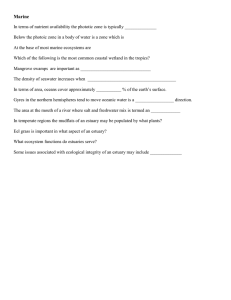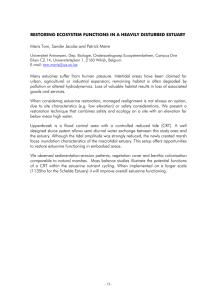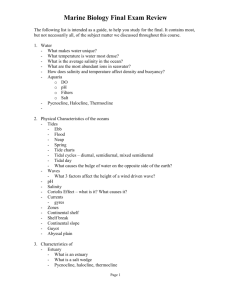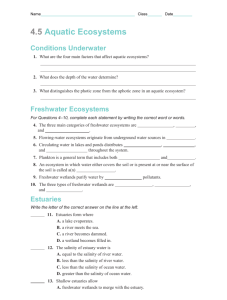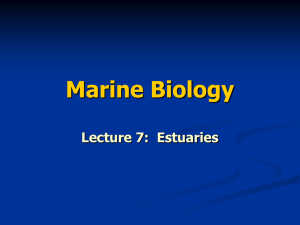Fish distribution dynamics in the RESEARCH COMMUNICATIONS
advertisement
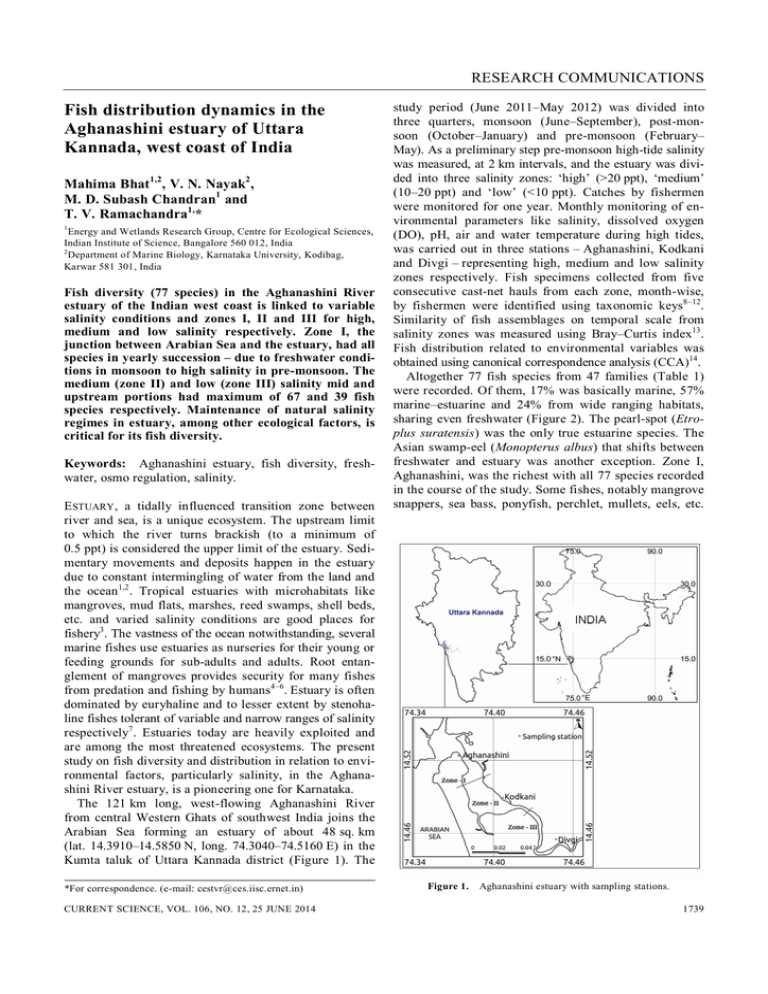
RESEARCH COMMUNICATIONS Fish distribution dynamics in the Aghanashini estuary of Uttara Kannada, west coast of India Mahima Bhat1,2, V. N. Nayak2 , M. D. Subash Chandran1 and T. V. Ramachandra1,* 1 Energy and Wetlands Research Group, Centre for Ecological Sciences, Indian Institute of Science, Bangalore 560 012, India 2 Department of Marine Biology, Karnataka University, Kodibag, Karwar 581 301, India Fish diversity (77 species) in the Aghanashini River estuary of the Indian west coast is linked to variable salinity conditions and zones I, II and III for high, medium and low salinity respectively. Zone I, the junction between Arabian Sea and the estuary, had all species in yearly succession – due to freshwater conditions in monsoon to high salinity in pre-monsoon. The medium (zone II) and low (zone III) salinity mid and upstream portions had maximum of 67 and 39 fish species respectively. Maintenance of natural salinity regimes in estuary, among other ecological factors, is critical for its fish diversity. Keywords: Aghanashini estuary, fish diversity, freshwater, osmo regulation, salinity. E STUARY, a tidally influenced transition zone between river and sea, is a unique ecosystem. The upstream limit to which the river turns brackish (to a minimum of 0.5 ppt) is considered the upper limit of the estuary. Sedimentary movements and deposits happen in the estuary due to constant intermingling of water from the land and the ocean1,2 . Tropical estuaries with microhabitats like mangroves, mud flats, marshes, reed swamps, shell beds, etc. and varied salinity conditions are good places for fishery3. The vastness of the ocean notwithstanding, several marine fishes use estuaries as nurseries for their young or feeding grounds for sub-adults and adults. Root entanglement of mangroves provides security for many fishes from predation and fishing by humans4–6. Estuary is often dominated by euryhaline and to lesser extent by stenohaline fishes tolerant of variable and narrow ranges of salinity respectively7 . Estuaries today are heavily exploited and are among the most threatened ecosystems. The present study on fish diversity and distribution in relation to environmental factors, particularly salinity, in the Aghanashini River estuary, is a pioneering one for Karnataka. The 121 km long, west-flowing Aghanashini River from central Western Ghats of southwest India joins the Arabian Sea forming an estuary of about 48 sq. km (lat. 14.3910–14.5850 N, long. 74.3040–74.5160 E) in the Kumta taluk of Uttara Kannada district (Figure 1). The *For correspondence. (e-mail: cestvr@ces.iisc.ernet.in) CURRENT SCIENCE, VOL. 106, NO. 12, 25 JUNE 2014 study period (June 2011–May 2012) was divided into three quarters, monsoon (June–September), post-monsoon (October–January) and pre-monsoon (February– May). As a preliminary step pre-monsoon high-tide salinity was measured, at 2 km intervals, and the estuary was divided into three salinity zones: ‘high’ (>20 ppt), ‘medium’ (10–20 ppt) and ‘low’ (<10 ppt). Catches by fishermen were monitored for one year. Monthly monitoring of environmental parameters like salinity, dissolved oxygen (DO), pH, air and water temperature during high tides, was carried out in three stations – Aghanashini, Kodkani and Divgi – representing high, medium and low salinity zones respectively. Fish specimens collected from five consecutive cast-net hauls from each zone, month-wise, by fishermen were identified using taxonomic keys8–12. Similarity of fish assemblages on temporal scale from salinity zones was measured using Bray–Curtis index13. Fish distribution related to environmental variables was obtained using canonical correspondence analysis (CCA)14. Altogether 77 fish species from 47 families (Table 1) were recorded. Of them, 17% was basically marine, 57% marine–estuarine and 24% from wide ranging habitats, sharing even freshwater (Figure 2). The pearl-spot (Etroplus suratensis) was the only true estuarine species. The Asian swamp-eel (Monopterus albus) that shifts between freshwater and estuary was another exception. Zone I, Aghanashini, was the richest with all 77 species recorded in the course of the study. Some fishes, notably mangrove snappers, sea bass, ponyfish, perchlet, mullets, eels, etc. Figure 1. Aghanashini estuary with sampling stations. 1739 RESEARCH COMMUNICATIONS Table 1. Code used Marine 3 4 5 6 7 8 9 10 32 42 77 68 76 Checklist of Ichthyofauna observed in Aghanashini estuary (categorization based on www.fishbase.org, accessed on 19 January 2014) Family Scientific name Common name Local name (Kannada) Carangoides praeustus Rastrelliger kanagurta Nemipterus japonicus Cephalopholis boenak Crossorhombus azureus Pseudorhombus javanicus Scomberomorus commerson Pampus argenteus Glaucostegus halavi Siganus argenteus Parrot fish Colletteichthys dussumieri Ephinephelus bleekeri Brownback trevally Indian Mackerel Japanese thread fin bream Blue lined coral cod Blue spotted flounder Javan flounder Narrow-barred Spanish mackerel Silver pomfret Halavi ray Streamlined spinefoot – Flat toad fish Bleeker's reef cod Haluguruku Bangade Rane menu Gobrya, Kallumurge Masur leppe Nengu Iswana Bili manji Balagende torke Baana – Gonke, Goke Gobrya Marine, estuarine 1 Clupeidae 2 Engraulidae 12 Carangidae 13 Ariidae 14 Siganidae 15 Tetraodontidae 16 Engraulidae 17 Platycephalidae 18 Sillaginidae 19 Sciaenidae 20 Sphyraenidae 21 Lactariidae 22 Belonidae 23 Carangidae 24 Carcharhinidae 25 Platacidae 26 Carangidae 27 Dasyatidae 28 Clupeidae 29 Leiognathidae 30 Lobotidae 31 Engraulidae 33 Leiognathidae 35 Trichiuridae 38 Sphyraenidae 40 Cynoglossidae 41 Platacidae 43 Engraulidae 45 Engraulidae 46 Carangidae 47 Pempheridae 48 Pomadasyidae 50 Ariidae 51 Stromatidae 52 Sciaenidae 53 Lutjanidae 54 Lutjanidae 34 Soleidae 36 Sciaenidae 74 Hemiramphidae 37 Triacanthidae 39 Cynoglossidae 44 Gobiidae Sardinella fimbriata Stolephorus indicus Carangoids chrysophrys Arius arius Siganus vermiculatus Arothron stellatus Stolephorus commersonnii Grammoplites scaber Sillago sihama Otolithes ruber Sphyraena barracuda Lactarius lactarius Strongylura leiura Megalaspis cordyla Scoliodon laticaudus Drepane punctata Caranx ignobilis Himantura bleekeri Opisthopterus tardoore Leiognathus splendens Lobotes surinamensis Thryssa mystax Secutor insidiator Trichiurus lepturus Sphyraena obtusata Cynoglossus macrostomus Platax orbicularis Thryssa malabarica Thryssa setirostris Atule mate Pempheris moluca Pomadasys maculatus Arius Caelatus Parastromateus niger Chrysochir aureus Lutjanus johni Lutjanus ruselli Synaptura commersonnii Johnius belangeri Hemirhaphus far Tricanthus biaculeatus Paraplagusia biliniata Trypauchen vegina Fringescale sardinella Indian anchovy Brownback trevally Threadfin sea catfish Vermiculated spinefoot Starry blow fish Commerson’s anchovy Rough flathead Silver sillago Tigertooth croaker Great barracuda False trevally Banded needle fish Torpedo trevally Shark Spotted sickle fish Giant kingfish Bleeker’s whip ray Tardoore Blacktip ponyfih Tripletail Moustached thryssa Pugnose ponyfish Large head hairtail Obtuse barracuda Malabar sole Orbicular bat fish Malabar thryssa Long jaw thryssa Yellowtail scad Mollucan sweeper Saddle grunt Engraved sea catfish Black pomfret Reeve's croaker John’s snapper Russell’s snapper Commerson’s sole Belanger’s croaker Black barred half beak Short-nosed tripod fish Double lined tongue sole Burrowing goby Pedi Belanji Haluguruku Bili sady Baana, Padiyar Chonja Dodda danashi Vadati Nogla Banagu, Dodi Onakaandi Samdale Burkaandi Guruku Sora Chandaka Guruku Hola Pachage Guruku Pavade Vaintali Guruku Barik hamle Hallin kaandi Leppe Manji Vaintali Vaintali Guruku Ramachi Guruku Gonde Sady Kari manji Mooru hallin banagu Hottekemsa Kemsa Leppe Banagu Toli Kuduremeenu, kadbale Leppe Bombale Estuarine 56 Etroplus suratensis Pearl spot Kagalse Carangidae Scombridae Nemipteridae Serranidae Bothidae Paralichthyidae Scombridae Stromatidae Rhinobatidae Siganidae Scaridae Batrachoididae Serranidae Cichilidae (Contd) 1740 CURRENT SCIENCE, VOL. 106, NO. 12, 25 JUNE 2014 RESEARCH COMMUNICATIONS Table 1. Code used (Contd) Family Scientific name Common name Local name (Kannada) Estuarine freshwater 58 Synbranchidae Monopterus albus Asian swamp eel Kolav Marine, estuarine, freshwater 11 Scatophagidae 55 Lutjanidae 57 Gobiidae 59 Gobiidae 61 Mugilidae 62 Mugilidae 63 Polynemidae 64 Teraponidae 60 Gerridae 65 Gerridae 66 Leiognathidae 67 Centropomidae 69 Ambassidae 70 Cynoglossidae 71 Ophichthidae 73 Ophichthidae 72 Apogonidae 75 Clupeidae Scatophagus argus Lutjanus argentimaculatus Glossogobius giuris Acentrogobius griseus Mugil cephalus Liza parsia Eleutheronema tetradactylum Terapon jarbua Gerres filamentosus Gerres limbatus Secutor ruconius Lates calcarifer Ambassis ambassis Cynoglossus punticeps Pisoodonophis cancrivorus Lamnostoma polyophthalma Apogon hyalosoma Tenualosa ilisha Spotted scat Mangrove red snapper Tank goby Grey goby Flathead grey mullet Gold spot mullet Four finger threadfin Cresent pearch Threadfin silver biddy Saddleback silver biddy Deep pugnose ponyfish Barramundi, Seabass Commersons glassy perchlet Spotted tongue sole Snake eel Ocellated sand-eel Humpbacked cardinal fish River shad Hulka Eri Bili Mandli Kari mandli Madle Madle Raws, Ramachi Kumbari, Garge Girbaingi Mundbaingi Guruku Kurude Burante Leppe Aragotka Hemalga Burante Malati pedi Uncertain habitat 49 Scorpinidae Scorpeana haplodactylus – – Figure 2. Habitat combinations of estuarine fishes of Aghanashini (based on www.fishbase.org accessed on 19 January 2014). M, Marine; M, E, Marine, estuarine; E, Estuarine; E, F, Estuarine, freshwater; M, E, F, Marine, estuarine, freshwater. inhabited here throughout monsoon to pre-monsoon. The marine–estuarine group, mainly anchovis, croakers, barracudas, snappers, sillagos, black pomfrets, soles, etc. kept away from zone I during monsoon. Such euryhaline fishes entered the zone from the sea only from postmonsoon with rising salinity. The stenohaline marine fishes, notably mackerels, silver pomfrets and cods appeared in Aghanashini when salinity levels peaked in the pre-monsoon months. The mid-estuarine zone II (Kodkani) had 67 species, most of them euryhaline. Stenohaline marine fish avoided this medium-salinity zone. Only 39 species occurred in zone III (Divgi), the interphase with freshwater. They were mostly a subset of zone II and moved freely between the sea and the estuary; some even CURRENT SCIENCE, VOL. 106, NO. 12, 25 JUNE 2014 entered freshwater. Exclusive freshwater species were absent in the estuary even during the rainy season. The families Carangidae and Engraulidae had five species each; Sciaenidae had four species; Clupeidae, Cynoglossidae, Gobiidae, Leiognathidae and Lutjanidae had three species each. Eleven families were represented by 2 species, while 28 had only 1 each. A comparable study from Ponnani estuary in Kerala had 112 species from 53 families15. Carangidae with eight, Leiognathidae with seven and Engraulidae with six species each followed. From Kodungallur–Azhikode estuary of Kerala, 63 fishes of 37 families were reported. Mugilidae had five and Engraulidae, Carangidae, Cyprinidae, Cichilidae and Gerridae had three each 16. From Yedayanthittu estuary in Tamil Nadu, 75 species of 37 families were reported17. Monthly variations in environmental parameters like salinity, pH, DO, water and air temperatures of the three zones are depicted in Figure 3 a–c respectively. Heavy rains (2500–5000 mm), in the catchment areas, caused salinity drop to nil or very low; from marginal rise in September to zone-wise peaks were attained in March– May. Similar pattern was observed in the Naaf estuary of Bangladesh, by Chowdhury et al.18, when July rainfall (1159 mm) caused salinity to decline to 0–8.6 ppt. Aghanashini estuary had maximum DO (6.32 mg/l) during monsoon to early post-monsoon. It was similar in Vellar, Tamil Nadu19. Pre-monsoon saw highest water temperature in Aghanashini (31.5C) and lowest (25.6C) during monsoon. Water temperature was lower than air temperature, which was higher in October, April and May. 1741 RESEARCH COMMUNICATIONS Figure 3. Hydrological parameters observed at (a) zone I (Aghanashini), (b) zone II (Kodkani) and (c) zone III (Divgi) during June 2011– May 2012. When 77 species and 5 environmental variables from Aghanashini estuary were selected for CCA analysis (Figure 4), the first two components had eigenvalues, 1 = 0.119, 2 = 0.051. Axis 1 accounted for 55.32% of the cumulative percentage of variance in species abundance with environmental parameters and was positively correlated with salinity, water and air temperatures and negatively correlated with DO and pH. Axis 2 explained 24.1% variance and was positively correlated with salinity, pH and air temperature, and negatively with DO and water temperature. CCA showed most fishes exhibiting positive correlation with salinity. Few like Strongylura leiura, Hemirhampus far and parrot fish showed negative correlation with salinity as these occurred mainly during monsoon. 1742 Bray–Curtis analysis of monthly fish assemblage distinguished two (A and B) major groups (Figure 5). Cluster A was grouped into all the seasons of zone III (Divgi) and three months (October, November and December) of zone II (Kodkani). In this group fishes such as Sillago sihama, Otolithes ruber, Lutjanus johni, Lutjanus ruselli, Lutjanus argentimaculatus, Etroplus suratensis, Glossogobius giuris, Gerres filamentosus, Mugil cephalus, Terapon jarbua were shared between zones II and III. These are among well-known indicators of highly variable estuarine salinity conditions. Cluster B consists of two sub-groups, namely cluster B1 and B2; B1 is further sub-divided into B1 -I and B1-II. B1 -I clustered with postmonsoon season of zone I (Aghanashini) and premonsoon season of zone II. Clustering of this nature reveals that many estuarine fishes have their own preferable salinity regimes necessitating constant movement of fishes within the estuary in adjustment with dynamic salinity conditions depending on mixing of fresh and salt waters. The cluster B1-II shows that the fish assemblages are 92% similar and closely related to the pre-monsoon (April and May) of zone I. Predominantly marine fishes like Rastrelliger kanagurta, Scomberomorus commerson and Pampus argenteus get into this high-salinity (34 ppt) assemblage. However, George et al.20 had reported mackerels (R. kanagurta) from Netravati estuary of Mangalore during January in lesser salinity (14.10–23.50 ppt). Estuarine life is more challenging than marine mainly because of fluctuating salinity. Fishes of specific salinity ranges keep shifting positions within their respective ranges. The osmoregulation mechanism in fishes and species-specific operating ranges in relation to salinity are of great interest to fish physiologists21,22 . Through osmoregulation the fish maintains an internal balance of salt and water within the cells when there is difference in salinity between internal and external conditions. Various cellular-level mechanisms exist safeguarding fishes from high salinity and fluctuations in salinity21–25. The estuarine–freshwater fish Seabass (Lates calcarifer) requires greater depths (10–15 m), hardly available in the estuary, and higher salinity conditions (30–32 ppt) for gonadial maturity, making it migrate from the river into the sea for spawning during monsoon. The spawning happens in September and the larvae move into the estuary for further development26. The Aghanashini study has notable similarity with works in the Caete River estuary27 of Brazil. Both the basins have hot and humid weather, five to six rainy months and annual rainfall exceeding 2500 mm. In both seasonal salinity fluctuations appeared to be the main factor that structured fish assemblage in the entire estuarine system. At least 85% of the 82 species captured by the artisanal fishers of the adjoining Brazilian coast required estuarine conditions to complete their life cycle. While the study reveals that 74 of the 77 species recorded from Aghanashini used sea as a common habitat, the estuary CURRENT SCIENCE, VOL. 106, NO. 12, 25 JUNE 2014 RESEARCH COMMUNICATIONS Figure 4. Canonical correspondence analysis of Aghanashini estuary on fish species numbers and month-wise environmental parameters. JN, January; FB, February; MR, March; AP, April; MY, May; JU, June; JL, July; AU, August; SP, September; OC, October; NV, November; DC, December. Square indicates zone I with corresponding month; diamond indicates zone II with corresponding month and triangle indicates zone III with corresponding month. Numbers = Fish species; Line = Environmental parameters. plays a significant role in their lives highlighting the importance of its conservation. Tropical estuaries in their natural states are rich in fisheries. Of the prominent environmental parameters considered in the study, salinity was the most decisive in fish distribution. The estuary as such had hardly any exclusive fish, with minor exceptions. Zone I closest to the sea had highest diversity as it experienced lowest salinity during monsoon and highest during pre-monsoon, facilitating seasonal fish succession from low- to highsalinity species; many euryhaline fishes with wider salinity tolerance range occupied the zone throughout the year. There is also need to protect estuarine microhabitats like mangroves, sedge areas, mud-flats, shell-beds, etc. for healthy assemblage of fishes. As regards salinity many estuaries of the west coast are seriously affected by execution of hydro-electric projects, the water releases from which adversely affect salinity regimes with adverse consequences on fish diversity and fisheries itself. Fishery collapse has happened in the Sharavathi estuary of Uttara Kannada, which has only 29 fin fish species, unlike 77 in Aghanashini, attributed to year-round salinity drop due to constant freshwater releases from upstream hydro-electric projects28. River diversion from the Western Ghats, with scanty consideration for environment, particularly estuarine ecology, is a burning topic today. Figure 5. Bray–Curtis clustering of fish species in Aghanashini estuary. CURRENT SCIENCE, VOL. 106, NO. 12, 25 JUNE 2014 1. Pritchard, D. W., Observations of circulation in coastal plain estuaries. In Estuaries (ed. Lauff, G. H.), American Association for the Advancement of Science, 1967, vol. 83, pp. 37–44. 1743 RESEARCH COMMUNICATIONS 2. Elliotta, M. and McLusky, D. S., The need for definitions in understanding estuaries. Estuarine Coastal Shelf Sci., 2002, 55, 815–827. 3. Breine, J., Maes, J., Ollevier, F. and Stevan, M., Fish assemblages across a salinity gradient in the Zeeschelde estuary (Belgium). Belg. J. Zool., 2011, 141, 21–44. 4. Cronin, L. E. and Mansueti, A. J., The biology of the estuary. In Proceedings of the Symposium on the Biological Significance of Estuaries, Sport Fishing Institute, Washington DC, 1971, pp. 24–39. 5. Day, J. H., Blaber, S. J. M. and Wallace, J. H., Estuarine fishes. In Estuarine Ecology in Particular Reference to Southern Africa (ed. Day, J. H.), Balkema, Rotterdam, 1981, pp. 197–121. 6. Dando, P. R., Reproduction in estuarine fishes. In Fish Reproduction: Strategies and Tactics (eds Potts, G. W. and Wootton, R. J.), Academic Press, London, 1984, pp. 155–170. 7. Blaber, S. J. M., Tropical Estuarine Fishes: Ecology, Exploitation and Conservation, Fish and Aquatic Resources Series, Blackwell Science, Oxford, 2000, vol. 7, pp. 1–372. 8. Day, F., The Fauna of British India including Ceylon and Burma, Today & Tomorrow Printers and Publishers, New Delhi, Reprinted 1989, vols I and II. 9. Talwar, P. and Jhingran, A., Inland Fishes of India and Adjacent Countries, Oxford & IBH, New Delhi, 1991, vols 1 and 2. 10. Munro, S. R., The Marine and Freshwater Fishes of Ceylon, Biotech Books, Tri Nagar, Delhi, 2000, pp. 1–349. 11. Jayaram, K. C., In FAO species identification sheets for fishery purposes (eds Fischer, W. and Bianchi, G.), Western Indian Ocean fishing area 51. FAO, Rome, 1984, vols I–VI. 12. www.fishbase.org (accessed on 14 February 2013). 13. Bray, J. R. and Curtis, J. T., An ordination of the upland forest communities of Southern Wisconsin. Ecol. Monog., 1957, 27, 325–349. 14. Ter Braak, C. J. F., Correspondence analysis of incidence and abundance data: properties in terms of a unimodal response model. Biometrics, 1985, 41, 859–873. 15. Bijukumar, A. and Sushama, S., Ichthyofauna of Ponnani estuary, Kerala. J. Mar. Biol. Assoc. India, 2000, 42, 182–189. 16. Jayachandran, P. R., Nandan, S. B., Sreedevi, O. K. and Sanu, V. F., Influences of environmental factors on fish assemblage in the Tropical Estuary of Southwest coast of India. A case study of Kodungallur–Azhikode–Estuary. Int. J. Mar. Sci., 2013, 3, 4–16. 17. Ramanujam, M. E. and Anbarasan, R., A preliminary report on the Ichthyofauna of Yedayanthittu Estuary (Tamil Nadu, India) and rivulets draining into it. J. Threat. Taxa, 2009, 1, 287–294. 18. Chowdhury, M. S. N., Hossain, M. S., Das, N. G. and Barua, P., Environmental variables and fisheries diversity of the Naaf River Estuary, Bangladesh. J. Coastal Conserv., 2010, 15, 163–180. 1744 19. Brinda, S., Srinivasan, M. and Balakrishnan, S., Studies on diversity of fin fish larvae in Vellar Estuary, southeast coast of India. W. J. Fish Mar. Sci., 2010, 2, 44–50. 20. George, P. C., Dhulkhed, M. H. and Ramamohana Rao, V., Observations on the mackerel fishery of the Netravali Estuary, west coast, South India. J. Bombay Nat. Hist. Soc., 1959, 56, 32–38. 21. McCormick, S. D. and Bradshaw, D., Hormonal control of salt and water balance in vertebrates. Gen. Comp. Endocrinol., 2006, 147, 3–8. 22. Evans, D. A., brief history of the study of fish osmoregulation: the central role of the Mt. Desert Island Biological Laboratory. Front. Physiol., 2010, 1, 1–10. 23. Evans, D. H., Teleost fish osmoregulation: what have we learned since August Krogh, Homer Smith, and Ancel Keys. Am. J. Physiol. Regul. Integr. Comp. Physiol., 2008, 295, 704–713. 24. Nordlie, F. G., The influence of environmental salinity on respiratory oxygen demands in the euryhaline teleost, Ambassis interrupt a bleeker. Comp. Biochem. Physiol. Part A: Physiol., 1978, 59, 271–274. 25. Plaut, I., Resting metabolic rate, critical swimming speed and routine activity of the euryhaline Cyprionodontid, Aphanius dispar, acclimated to a wide range of salinities. Physiol. Biochem. Zool., 2000, 73, 590–596. 26. Mathew, G., Taxonomy, identification and biology of Seabass (Lates calcarifer). In National Training on ‘Cage Culture of Seabass’, CMFRI, Kochi, 2009, pp. 38–43. 27. Barletta, M., Barletta-Bergan, A., Saint-Paul, U. and Hubold, A., The role of salinity in structuring the fish assemblages in a tropical estuary. J. Fish Biol., 2005, 66, 45–72. 28. Ramachandra, T. V., Subash Chandran, M. D., Joshi, N. V., Mahima, B., Prakash, N. M. and Sreekanth, N. Estuarine fish diversity and livelihoods in Uttara Kannada district, Karnataka State. Sahyadri Conservation Series 34, ENVIS Technical Report 64, CES, Indian Institute of Science, Bangalore, 2013, pp. 1–100. ACKNOWLEDGEMENTS. We thank the Ministry of Environment and Forests, Government of India and Indian Institute of Science, Bangalore for financial and infrastructural support. We also thank Kusuma Neelakantan, Geeta Sasikumar and Prashant for guidance in fish identification and Balachandran, Boominathan, Praksah Mesta, Shrikanth Naik and Vishnu Mukri for help. Received 25 April 2013; revised accepted 26 April 2014 CURRENT SCIENCE, VOL. 106, NO. 12, 25 JUNE 2014
